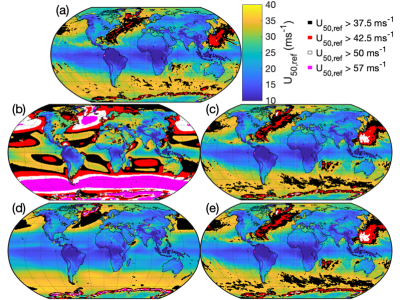Digital Atlas of Extreme Wind Speeds
Estimation of extreme wind speeds is critical to wind turbine design for structural integrity and capital costs for a given site. Such estimates are not available for most locations or are subject to large uncertainty due to temporally limited on-site measurements. We derive, validate, and distribute the first global, homogenized, and geospatially explicit digital atlas of U50. The atlas includes U50 estimates from five different methods along with associated confidence intervals and indications of areas with mixed wind climates and/or evidence of climate non-stationarity. The analyses are based on forty years of hourly ERA5 reanalysis output in a million global grid cells and are derived using a range of geospatial statistics. Evaluation of U50 estimates at 100 m a.g.l. relative to estimates from point in situ observations at 73 locations around the globe indicate relatively high fidelity. Spatially averaged mean absolute errors of 5.3-6.7 ms-1 or 9 to 13% are consistent with expectations of comparison between grid cell averaged estimates and point measurements due to spectral truncation
At the end of 2019 total global wind turbine installed capacity exceeded 651 GW due in part to addition of over 60 GW of new capacity. A substantial fraction of global installed capacity is in Europe (22% of onshore, 66% of offshore), China (37% of onshore, 23% of offshore), and the USA (17% of onshore), but there are now wind turbines deployed in over 90 countries. Prospective and current deployment locations include many areas where there is only very limited access to in situ measurements of wind speeds at wind turbine relevant heights and/or access to data regarding power production from existing wind turbine arrays. This data gap enhances uncertainty and perceived project risk and thereby inflates financing costs. Further cost-effective expansion of the wind energy industry will benefit from more robust and spatially explicit estimates of wind resources and operating conditions. Extreme loads are a key component of wind turbine design and selection and are determined in part by the 50-year return period sustained wind speed (U50), that is the 10-minute sustained wind speed at hub height that is expected to occur once in 50-years. However, access to robust assessments of U50 are available for very few locations in the world and thus are often approximated by the wind energy industry using Uref computed as 5 times in the mean annual mean wind speed. It is shown that this estimation method used in the wind turbine design standard is generally a conservative estimate of U50. Particularly after the application of additional safety factors, this may result in over-engineering of wind turbines and excess capital expenditures
Cost-effective expansion of the wind energy industry benefits from robust estimates of wind resource and operating conditions. Extreme design loads contribute to wind turbine selection and cost, and are determined in part by the fifty-year return period sustained wind speed (U50). Here we derive, evaluate, report and distribute a global, homogenized and geospatially explicit digital atlas of U50 and associated confidence intervals based on ERA5 reanalysis output at wind turbine hub-heights. It is anticipated that this resource will enable and spur expansion of the wind energy industry and enable continued reductions of the levelized cost of energy from wind.

